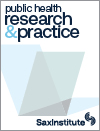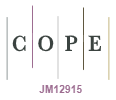Public Health Research and Practice
Volume 35
Number 2 2025
Maternal and infant health services are vital for Aboriginal infants to have the best possible start to life. These services are not evenly distributed, leaving some Aboriginal families unable to access the care needed for both mums and babies. Being unable to access these important services affects babies’ growth and development. Culturally safe and targeted services based on population needs are required to improve continuity of care in the first 1000 days.
Despite the critical role of healthcare providers in increasing vaccine coverage and public confidence in vaccines, they have limited engagement with vaccine safety surveillance systems in Australia. This study examined the awareness and practices of healthcare providers in relation to vaccine safety surveillance systems and found that gaps exist, particularly with AusVaxSafety, and that efforts must be made to increase the accessibility and utility of AusVaxSafety vaccine safety data.
COVID-19 highlighted the importance of epidemiological evidence in understanding the dynamics of viral transmission and informing policy. The pandemic also revealed gaps globally in evidence generation and investment in a coordinated approach to surveillance data reporting and evidence synthesis. Real-time public health research in crises must have infrastructure in place to support granular real-world investigation into who is at most risk of exposure, and disease and intervention impacts, especially in low- and middle-income countries where health resources are limited.
This article belongs to the collection: A Decade of Insight: 10th Anniversary Collection of Public Health Research & Practice.
Indoor mould exposure is increasingly recognised as a physical and mental health stressor. Our article investigates the experiences and perceptions of Australian residents living in mould-affected housing, exploring the causes of mould growth, the health impacts, and the barriers to fixing mould problems. Our findings emphasise the need for better education on mould prevention and remediation plus better regulations to enforce rental and building minimum standards.
Food insecurity in early childhood has adverse effects throughout life; however, little is known about how many young children in Australia experience a lack of access to food. This research investigates trends in the prevalence of children who arrived at school hungry in their first year of school in Australia from 2009 to 2021, with findings aligned with evidence that food insecurity is growing. There is a need to explore how school meal provision can better support children experiencing food insecurity.
This project aimed to co-design a strategic consumer involvement framework for an Australian hospital and health service. Using a co-design approach, the project involved five stages: stakeholder consultation, staff survey, group sessions with consumers and staff, data synthesis, and a final workshop. Results identified a need for governance, infrastructure, capacity building, and leadership and culture to support consumer involvement in research. Implementation strategies were adapted to the local context. The project emphasises the importance of supporting consumer–researcher collaboration, offering a blueprint for creating local, contextualised strategies to enhance the relevance and impact of research in Australian hospital and health services.
Australia is a global leader in skin cancer research and prevention, yet it lacks comprehensive data on the incidence of the most common skin cancers in the population, basal cell carcinoma and squamous cell carcinoma, hindering control efforts. This manuscript highlights the critical need for reliable national data on the incidence of these cancers, which pose a significant public health burden. Comprehensive registration can inform evidence-based policy, improve prevention strategies and ultimately reduce the burden of these cancers.
This is the first perspective in a series of four reviewing the past decade in preventive health. While the gains won in selected areas of public health in Australia over the last decade should be acknowledged, the nation continues to fall short of the aspirations expressed in its prevention policies. Sporadic and disjointed implementation are perennial issues. The governance, organisational and funding requirements for effective prevention need to be addressed. The National Preventive Health Strategy 2021–2030 and the Australian Centre for Disease Control are current opportunities for improving the leadership and coordination of implementation across sectors and agencies.
This article belongs to the collection: A Decade of Insight: 10th Anniversary Collection of Public Health Research & Practice.
This is the fourth perspective in a series of four reviewing the past decade in preventive health. Despite successfully lowering smoking rates, tobacco use remains a leading cause of preventable illness and death in Australia. Reducing smoking prevalence to no more than 5% by 2030 could be readily achieved with continued tobacco control policy innovation. Australia has the opportunity to once again be a global leader in tobacco control by adopting world-first polices that strictly limit where and how easily tobacco is sold.
This article belongs to the collection: A Decade of Insight: 10th Anniversary Collection of Public Health Research & Practice.
This is the third perspective in a series of four reviewing the past decade in preventive health. Preventing illness is a core part of what general practice does. Over the past 10 years, screening for cancer, prevention of heart disease and immunisation have all increased. However, assessment and referral of patients with overweight and unhealthy behaviours has remained too infrequent due to high workload, inappropriate funding and poorly developed information systems.
This article belongs to the collection: A Decade of Insight: 10th Anniversary Collection of Public Health Research & Practice.
This is the second perspective in a series of four reviewing the past decade in preventive health. First Nations peoples have long practised holistic, community-led approaches to health and wellbeing. This paper explores how the National Preventive Health Strategy (NPHS) can better embrace Indigenous strengths and knowledge to improve health outcomes. By privileging First Nations leadership, cultural governance, and meaningful partnerships as core business in health policy, the paper highlights opportunities to create a more inclusive and effective approach to preventive health – one that supports self-determination and long-term wellbeing for communities.
This article belongs to the collection: A Decade of Insight: 10th Anniversary Collection of Public Health Research & Practice.
The rising use of e-cigarettes in many parts of the world is a public health concern, including Australia. Health professionals are important for supporting e-cigarette cessation, so we reviewed and summarised data on the facilitators and barriers to the support they can provide. We found that, although a sense of responsibility, intention and environmental resources act as facilitators, lack of knowledge, training, and competing priorities impact the capacity of health professionals to support e-cigarette cessation in Australia.
Many Australians rely on Medicare-subsidised services for managing chronic non-cancer pain (CNCP), but their use of such services remains unclear. We analysed Medicare-subsidised service use among Australians prescribed opioids for CNCP, revealing high use of primary, allied health, and specialist services compared with the general population. The findings highlight the need to address sociodemographic disparities and improve specialist service accessibility for uninsured and regional/remote Australians to better meet the needs of those with CNCP.
The large state-wide after-action review (AAR) of the COVID-19 public health response by NSW Health revealed important practice points to support future operational responses. It identified the importance of collective and systematic reflection, enabling the workforce to learn from past experiences and improve future responses. This process highlighted the value of involving multidisciplinary teams and considering the psychological needs of the workforce, setting a precedent for better preparedness in public health emergencies.
Children from low-socioeconomic communities are more likely to have health and development problems when starting school for the first time. We analysed medical records of children from five schools in a rural, low-socioeconomic community of NSW to quantitatively describe their healthcare needs and to inform school entry health check programs and school-based healthcare. The prevalence of health and developmental concerns and challenges to accessing care indicates the need for school entry health check models that provide ongoing support to families.
Improving oral health has taken centre stage at a global level; but in Australia, the public voice has been absent from such discussions. Here, we quantify opinions of working-age Australians on the essentiality and affordability of oral health care and show that, although it is considered essential, there is a clear barrier to accessibility due to unaffordability, particularly for disadvantaged groups. Universal oral health coverage principles need to be implemented for all Australians to receive equitable oral health care.




